4-Axis Pocketing | ||||
|
| |||
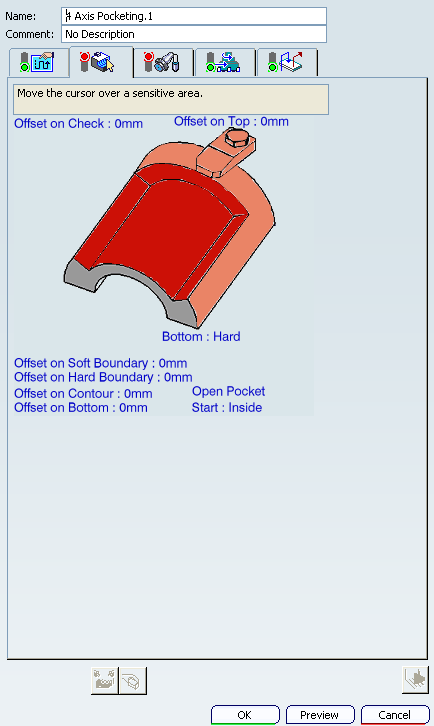
Machining Strategy Parameters
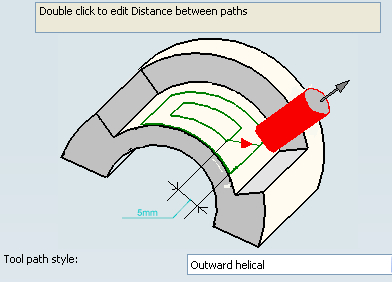
- Tool path style
- Specifies tool path style.
The options in the Tool path style dropdown combo box are as follows:
- Inward helical: the tool starts from a point inside the pocket and follows inward paths parallel to the boundary.
- Outward helical: the tool starts from a point inside the pocket and follows outward paths parallel to the boundary.
- Back and forth: the machining direction is reversed from one path to the next.
- Part offset One-way: tool motion is always done in the same direction following paths parallel to the boundary.
- Part offset Zig-zag: tool motion is done alternately in one direction then the other following paths parallel to the boundary.
![]()
Machining Parameters
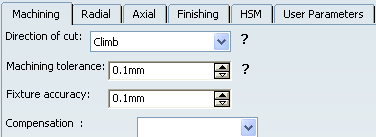
- Direction of cut
- Specifies how machining is to be done.
The options in the Direction of cut dropdown combo box are as follows:
- Climb milling: the front of the advancing
tool (in the machining direction) cuts into
the material first:
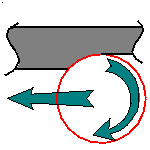
- Conventional milling: the rear of the
advancing tool (in the machining direction)
cuts into the material first:
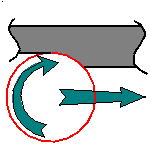
- Climb milling: the front of the advancing
tool (in the machining direction) cuts into
the material first:
- Machining tolerance
- Specifies the maximum allowed distance between the theoretical and computed tool path.
- Fixture accuracy
- Specifies a tolerance applied to the fixture
thickness.
If the distance between the tool and fixture is less than fixture thickness minus fixture accuracy, the position is eliminated from the trajectory. If the distance is greater, the position is not eliminated.
- Compensation
- Specifies the tool corrector identifier
to be used in the operation.
The corrector type (P1, P2, P3, for example), corrector identifier, and corrector number are defined on the tool. When the NC data source is generated, the corrector number can be generated using specific parameters.
![]()
Radial Parameters
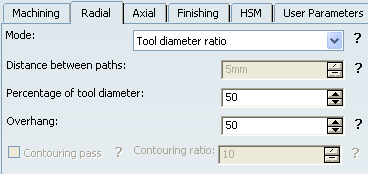
- Mode
- The options in the
Mode dropdown combo box specifies how the distance between two consecutive
paths is to be computed.
The options are:
- Maximum distance,
- Tool diameter ratio,
- Stepover ratio.
- Distance between paths
- Defines the maximum distance between two consecutive tool paths in a radial strategy.
- Percentage of tool diameter
- Defines the maximum distance between two
consecutive tool paths in a radial strategy
as a percentage of the nominal tool diameter.
Depending on the selected Radial mode this value is used as :
- Tool diameter ratio:
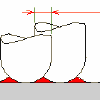
- Stepover ratio:

- Tool diameter ratio:
- Overhang
- Allows a shift in the tool position with
respect to the soft boundary of the machining
domain.
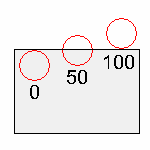
- Contouring pass
- Select this check box to allows a final machining pass around the
exterior of the trajectory for removing scallops.
This is available for 4-Axis Pocketing using a Back and Forth tool path style.
- Contouring ratio
- Adjusts the
position of the final contouring pass for removing
scallops. This is done by entering a percentage
of the tool diameter (0 to 50).
This is available for 4-Axis Pocketing using a Back and Forth tool path style.
![]()
Axial Parameters
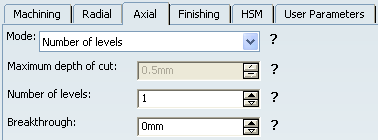
- Mode
- The options in the
Mode dropdown combo box specifies how the distance between two consecutive
levels is computed.
You can specify:
- Maximum depth of cut
- Number of levels
- Number of levels without top
- Maximum depth of cut
- Defines the maximum depth of cut in an axial strategy.
- Number of levels
- Defines the number of levels to be machined in an axial strategy.
- Breakthrough
- Specifies the distance in the tool axis direction that the tool must go completely through the part. Breakthrough is applied on the bottom element, which must be specified as soft.
![]()
Finishing Parameters
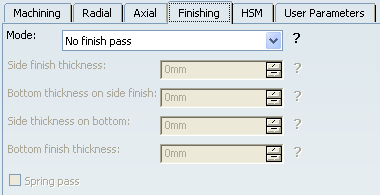
- Mode
- The options in the
Mode dropdown combo box indicate whether or not finish passes are
generated on the sides and bottom of the
area to machine.
The options are:
- No finish pass,
- Side finis last level,
- Side finish each level,
- Finish bottom only,
- Side finish at each level & bottom,
- Side finish at last level & bottom.
Note: In short, side finishing can be done at each level or only at the last level of the operation. Bottom finishing can be done without any side finishing or with different combinations of side finishing.
- Side finish thickness
- Specifies the thickness of material that
can be machined by the side finish pass.
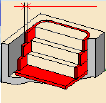
- Bottom thickness on side finish
- Specifies the bottom thickness used for
last side finish pass, if side finishing is
requested on the operation.
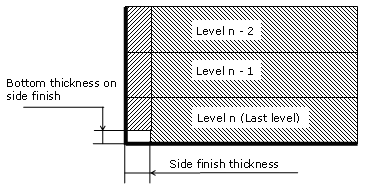
- Side thickness on bottom
- Specifies the thickness of material left
on the side by the bottom finish pass.

- Bottom finish thickness
- Specifies the thickness of material that
can be machined by the bottom finish pass.
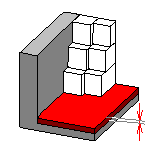
- Spring pass
- Select this check box to indicate whether or not a spring pass is to be generated on the sides in the same condition as the previous Side finish pass. The spring pass is used to compensate the natural spring of the tool.
![]()
Strategy: HSM Parameters
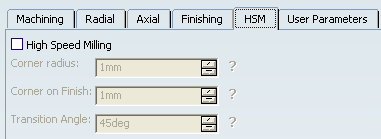
- High Speed Milling
- Select this check box to specify whether or not cornering for HSM is to be done on the trajectory.
- Corner radius
- Specifies the radius used for rounding the corners
along the trajectory of a HSM operation.
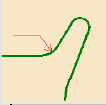
Note: Value must be smaller than the tool radius.
- Corner on Finish
- Specifies the radius used for rounding the corners
of the side finish path in a HSM operation.
Note: Value must be smaller than the tool radius.
- Transition Angle
-
Specifies the radius at the start and end of
the transition path when moving from one path
to the next in a HSM operation.
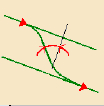
![]()
Geometry
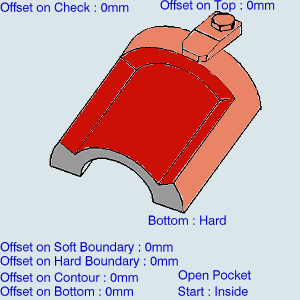
A 4-Axis Pocketing operation can be created for machining:
- Closed Pocket: the tool machines the area delimited by hard boundaries
- Open Pocket: the tool machines the area that has a least one soft boundary.
You can specify the following geometry:
- Pocket Bottom (cylindrical or conical surface) with possible Offset on Bottom. Bottom may be Hard or Soft.
- Pocket Boundary (edges or sketch) with possible:
- Offset on Hard Boundary
- Offset on Soft Boundary
- Offset on Contour. If you specify an Offset on Contour, it is added to any defined Offset on Hard Boundary and Offset on Soft Boundary.
- Pocket Top (cylindrical or conical surface) with possible Offset on Top.
- Check elements with possible Offset on Check.
Note: Start points are computed automatically and are located inside the pocket boundary. However, for open pockets, you can specify that the start point is to be located Inside or Outside the pocket. If it is outside the pocket, you must specify a clearance with respect to the pocket boundary.
![]()
Tools
Recommended tools for 4-Axis Pocketing are:
- End Mills
 ,
, - Face Mills
 ,
, - Conical
Mills
 , and
, and - T-Slotters
 .
.
![]()
Feedrates and Speeds Parameters
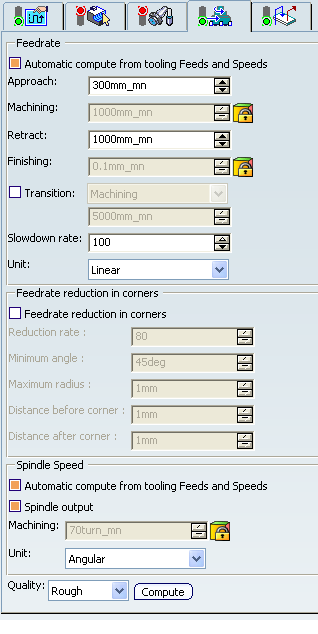
- Feedrate: Automatic compute from tooling Feeds and Speeds
- This check box allow an operation's feeds and speeds values to be updated automatically when the tool's feeds and speeds values are modified.
You can specify the following feedrates:
- Approach
- Machining
- Retract
- Finishing:
Note:
The above feedrates can be defined in linear (feed per minute) or angular (feed per revolution) units.
- Angular: feedrate in revolutions per minute and unit is set to mm_turn.
- Linear: feedrate in feed per minute and unit is set to mm_mn.
- Transition
- You can locally set the feedrate for a transition path to a
machining operation B from a machining operation A or from a tool
change activity. This is done by selecting the Transition check box in the Machining Operation dialog box for
operation B.
For more information, please refer to the Setting a Transition Feedrate.
- Slowdown Rate
- Reduces the current feedrate by a given percentage. The reduction is applied to the first channel cut and to the transitions between passes.
- Feedrate Reduction in Corners
- You can reduce feedrates in corners encountered along
the tool path depending on values given in the Feeds and Speeds
tab page:
- Reduction rate
- Maximum radius
- Minimum angle
- Distance before corner
- Distance after corner
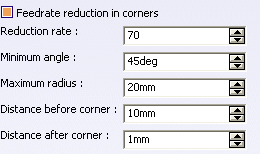
Feed reduction is applied to corners along the tool path whose radius is less than the Maximum radius value and whose arc angle is greater than the Minimum angle value.
For 4-axis Pocketing, feedrate reduction applies to machining and finishing passes:
- for all corners in Back and forth mode
- for inside corners in Helical mode.
Feedrate reduction does not apply for macros or default linking and return motions.
Corners can be angled or rounded, and may include extra segments for HSM operations.
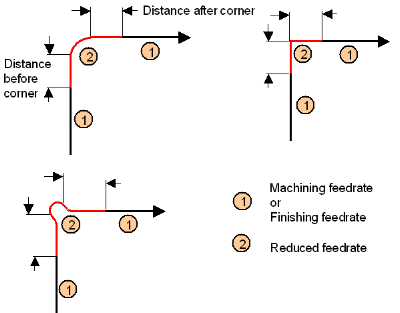
- Combining Slowdown Rate and Feedrate Reduction in Corners
If a corner is included in a slowdown path, the general rule is that the lowest percentage value is taken into account. For example:
- if the Slowdown rate is set to 70 % and Feedrate reduction rate in corners is set to 50%, the feedrate sequence is: 100%, 70% (entry in slowdown), 50% (entry in corner), 70% (end of corner, still in slowdown), 100% (end of slowdown).
- If feedrate Reduction rate in corners is then set to 75%, the feedrate sequence is: 100%, 70% (entry in slowdown), 70% (entry in corner: 75% ignored), 70% (end of corner, still in slowdown), 100% (end of slowdown).
- Spindle Speed: Automatic compute from tooling Feeds and Speeds
This check box allow an operation's feeds and speeds values to be updated automatically when the tool's feeds and speeds values are modified.
If the Feedrate Automatic compute check box is selected and the Spindle Speed: Automatic compute from tooling Feeds and Speeds check box is not selected, then only the feedrate values can be computed. If both are not selected then automatic updating is not done.
When you modify a tool's feeds and speeds, all existing operations with the Automatic compute check boxes selected that use this tool (or an assembly using this tool) can be recomputed.
- Spindle output
- This check box manage output
of the SPINDL instruction in the generated NC data file:
- If the check box is selected, the instruction is generated.
- Otherwise, it is not generated.
Note:
Spindle speed is applied on the different motions of the operations (including approach, retract, linking macros). Spindle can be re-defined with Spindle tool motion. The spindle speed can be defined in linear (length per minute) or angular (length per revolution) units.
- Angular: length in revolutions per minute and unit is set to mm_turn.
- Linear: length in feed per minute and unit is set to mm_mn.
- Quality
- The feed and speed values are computed according to the Quality setting on the operation.
- Compute
- Feeds and speeds of the operation can be updated according to tooling feeds and speeds by clicking the Compute button located in the Feeds and Speeds tab of the operation.
Feeds and speeds of the operation can be updated automatically according to tooling data and the Rough or Finish quality of the operation. This is described in About Feeds and Speeds.
![]()
NC Macros
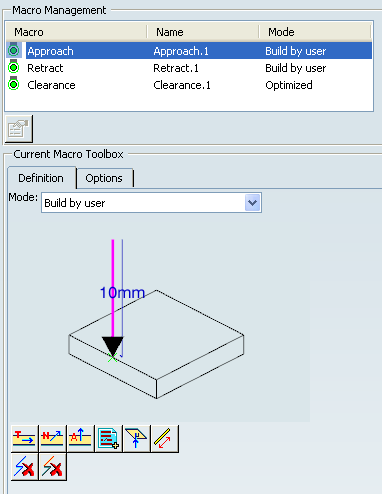
You can define transition paths in your machining operations by means
of NC macros:
- Approach: to approach the operation start point. A particular case of Ramping approach macro for pocketing is described in NC Macros.
- Retract: to retract from the operation end point,
- Linking:
- to link two non consecutive paths
- to access finish and spring passes.
- Return in a Level to link two consecutive paths in a given level in a multi-path operation
- Return between Levels to go to the next level in a multi-level machining operation,
- Return to Finish Pass to go to the finish pass
- Clearance to avoid a fixture, for example.
Note: When a collision is detected between the tool and the part or a check element, a clearance macro is applied automatically. If applying a clearance macro would also result in a collision, then a linking macro is applied. In this case, the top plane defined in the operation is used in the linking macro.
The proposed macro mode for Approach and Retract macro are:
- None
- Build by user
- Horizontal horizontal axial
- Axial
- Ramping
The proposed macro mode for Clearance macro are:
- Distance
- To a Plane
- To safety plane
For more information, please refer to the Defining Macros.